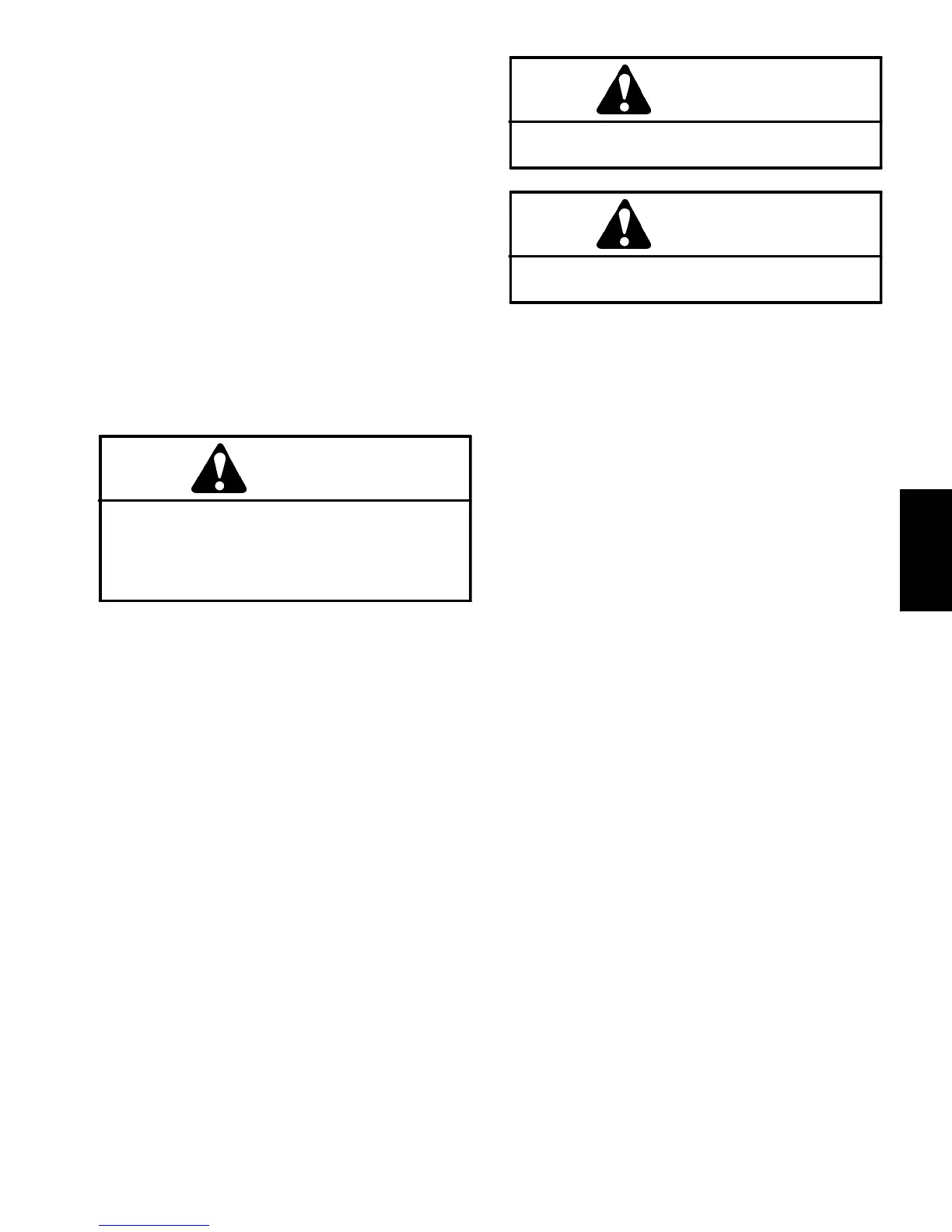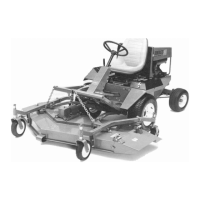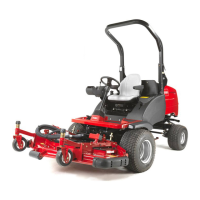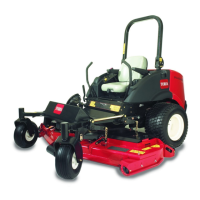Groundsmaster 4300--D Hydraulic SystemPage 4 -- 93
NOTE: The deck control manifold uses several zero
leak plugs.Theseplugs have atapered sealingsurface
on the plug head that is designed to resist vibration in-
ducedplugloosening.Thezeroleak plugsalsohavean
O--ring toprovide asecondary seal.Ifzero leakplug re-
moval is necessary, lightly rap the plug head using a
punch and hammer before using an allen w rench to re-
move the plug: the impact will allow plug removal with
less chance of damage to the socket head of the plug.
When installing plugs into the control manifold, torque
plugs to the values identified in Figures 81.
Deck Control Manifold Service
1. Makesurethemanifoldisthoroughlycleanedbefore
removing any cartridge valve.
2. If solenoidcartridge valveis being serviced,remove
nutsecuringsolenoidcoiltothecartridgevalve.Careful-
ly slide solenoid coil off the valve.
CAUTION
Beforeopeninghydraulicsystem,operateallhy-
draulic controls to relieve system pressure and
avoid injury from pressurized hydraulic oil. See
RelievingHydraulicSystemPressurein theGen-
eral Information section of this chapter.
IMPORTANT: Use care when removing cartridge
valves.Slight bending or distortion ofthestemtube
can cause binding and malfunction. Make sure that
deep well socket fully engages the valve base.
3. Using a deep well socket, remove cartridge valve
frommanifold. Note correctlocation ofO--rings, sealing
rings and backup rings. Remove and discard seal kit
from valve.
4. Visually inspect the manifold port for damage to the
sealingsurfaces, damagedthreads andcontamination.
5. Visuallyinspectcartridgevalvefor damagedsealing
surfaces and contamination.
A. Contaminationmaycausevalvestostickorhang
up.Contaminationc anbecomelodgedinsmallvalve
orifices or seal areas causing valve malfunction.
B. If valve sealing surfaces appear pitted or dam-
aged, the hydraulic system may be overheating or
there may be water in the system.
CAUTION
Use eye protection such as goggles when using
compressed air for cartridge valve cleaning.
CAUTION
Abrupt movement of internal spools can cause
stored fluid to be released suddenly.
6. Clean cartridge valve by submerging valve in clean
mineral spirits to flush out contamination. Particles as
fine as talcum powder can affect the operation of high
pressure hydraulic valves. If cartridge design allows,
usea woodor plasticprobeto pushthe internalspoolin
andout20to30timestoflushoutcontamination.Beex-
tremely careful not to damage cartridge. Use com-
pressed air for cleaning.
7. Reinstall cartridge valve into manifold:
A. Lubricatenewsealkitcomponentswithcleanhy-
draulic oil and install on valve. The O--rings, sealing
ringsandbackupringsmustbearrangedproperlyon
the cartridge valvefor proper operation andsealing.
IMPORTANT: Use care when installing cartridge
valves. Slight bending or distortion of the stem
tube can cause binding and malfunction. Make
sure that deep well socket fully engages the
valve base.
B. Threadcartridgevalvecarefullyintocorrectman-
ifoldport. Thevalve shouldgoin easilywithoutbind-
ing.
C. Torque cartridge valve using a deep well socket
to values identified in Figure 81.
8. If solenoid coil was removed from cartridge valve:
A. Carefully install coil onto the valve.
B. Install nut and torque nut to 60 in--lb (6.7 N--m).
Hydraulic
System

